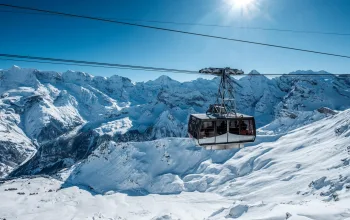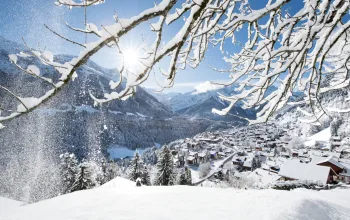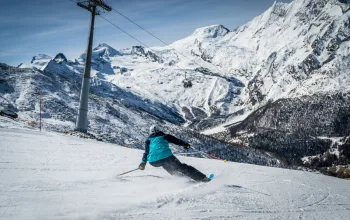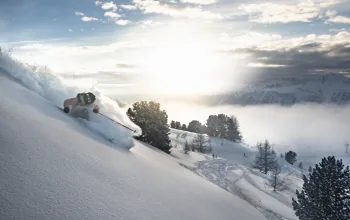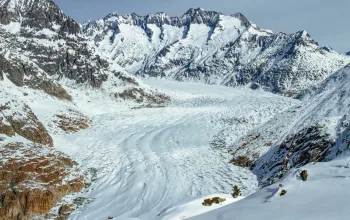Interlaken has no skiing of its own, with limited local skiing at Habkern, but it markets itself as the ideal base for skiing the different resorts in the Jungfrau (Grindelwald, Wengen, Mürren) linked by ski bus or rail (trips to Zermatt are also arranged). It's certainly a beautiful place to stay and guests profit from low season hotel rates during winter.
Mountain
Interlaken is well placed for visiting several of Europe's most famous resorts, notably Gstaad or Zermatt, a possible day trip. Closer still are major international resorts like Adelboden, Kandersteg and Andermatt. However most skiers head up in to the spectacular Jungfrau Region using the 'Top Ski' lift ticket which covers 45 lifts around Grindelwald, Wengen and Mürren. It's a virtually unique skiing experience with, arguably, the most dramatic mountain scenery in Europe all around you - the Eiger, the Mönch, the Wetterhorn and Mürren's Schilthorn as well as the Jungfrau itself all rising up to heights peaking at 4158 metres (13642 feet) from your Interlaken base of only 567 metres (1860 feet). And what a way to see it all too, with a 100 year old mountain railway always running on time from Interlaken right the way up to the Jungfraujoch. It is Europe's highest railway station at 3454 metres (11,333 feet) and site of a tiny summer skiing area on the glacier, where there's a single drag lift. It is also one of the 10 highest lift-served points in Europe. The train from Interlaken is included on the Pass are there is also an option to take a bus to Lauterbrunnen (beneath Wengen and Mürren) or to Grindelwald from Interlaken. The skiing of the Jungfrau region is of course legendary also, the annual Lauberhorn men's downhill race is the longest and one of the toughest FIS World Cup races, as well as one of the longest established. Indeed the reputation of Mürren and 'purpose-built' (in the mid-19th century) car-free Wengen in the history of competitive skiing, particularly with the early British pioneers of the sport, is well documented. It is home to the 'Downhill Only Club' (DHO) founded in the era after modern downhill skiing had been invented but before ski lifts had been. The 'new' mountain railway was then a wonderful way to reach the snow fields without walking and hence the Club was born, for people who didn't stand up to go uphill, just downhill only. I suppose most of us have since joined nominally, but you have to be the "right sort of chap" to be admitted in to Wengen's original, elite Club which still operates today. Across the valley at Mürren the Kandahar Club (see St Anton for Arlberg - Kandahar collaboration) was founded in 1924, a year before the DHO, and Sir Arnold Lunn pioneered slalom ski competition. Whilst Wengen has its legendary Lauberhorn, Mürren has the Inferno every January, probably the longest downhill race in the world and attracting over a thousand competitors. The run descends from the Schilthorn (3066 metres / 10,059 feet) to Lauterbrunnen in the valley above Interlaken, at 796 metres / 2,611 feet, an incredible 2,270 metre / 7,448 feet vertical descent. The record time for the full descent is 16 minutes although some skiers take over an hour, as they did in the 1920s. A shortened version operates when snow cover is inadequate at the bottom. For more general detail on the skiing of Mürren, Wengen and Grindelwald, which is generally described as an 'intermediates paradise', check the individual resort entries. There are three small ski areas within a few minutes of Interlaken at Wilderswil, first stop on the Jungfrau rail line out of the town, Beatenberg, and at Habkern. Wilderswil has only one surface lift but is well geared up for children and family skiing so should not be discounted as a starting point for beginners. Spread out on a sunny plateau above Lake Thun, with magnificent views of the Jungfrau's highest peaks, Beatenberg is a small, totally unspoilt settlement attracting visitors throughout the year. Habkern, further out, has about 8km (5 miles) of trails and a vertical of up to 963 metres (3160 feet). Neither Beatenberg nor Habkern are on the Jungfrau Top Ski pass however.
Families
Interlaken offers mixed blessings to skiing families. Those with children too young to ski won't find any real full-time day-care within the resort and, even if there was, probably would not want to leave small children so far behind when heading off up to the Jungfrau resorts. The best choice for daycare up the mountain is in Wengen, which accepts children from 3 months (there's another in Grindelwald taking children from 3 years), but Wengen is an hour by train each way - a spectacular journey sure to thrill children if they are interested by such things! On the other hand there are small family-friendly areas close to Interlaken if you don't care about missing out on the spectacular Jungfrau scenery and skiing to be with your child! Of course it's not such a big issue with older children, and all will appreciate the many child friendly facilities and eateries for kids down in Interlaken itself.
Eating Out
Interlaken's 50 restaurants provide a dining experience to suit everyone. Whilst traditional Swiss fayre is naturally enough the main menu on offer at most establishments, the resort does boast a wider choice of internationally themed restaurants than most Alpine resorts, including four different options from the East. The Interlaken Hotel features the Lotus Chinese restaurant as well as the traditional old Swiss 'Taverne' whilst the Carlton has a French restaurant and the Toscana offers 'Italian-Swiss' cuisine. For Japanese dishes visit the authentic 'Fujiyama' restaurant in the Kursaal. There are additional Thai, Indian and Korean restaurants in the town. Tips are included in the bill.
Apres
Interlaken's Höheweg is the 700 metre (half mile) long central boulevard lined with shops, hotels, cafés and restaurants - an ideal place for the early evening après ski on returning from the mountains. Of course there is no real 'après ski' here because skiers and 'boarders only make up a part of the town's clientele, even in winter, and few collapse into a bar after getting down from the slopes, most changing and eating before heading out on the town. However if you are around in the afternoon try the café Schuh for its legendary Swiss pastries. There is a night club, the Cabaret, with live music, dancing and entertainment at the Hotel Victoria - Jungfrau, with five additional discothèques open through to 3am and a popular "original English pub" at the Hotel Splendid. For typical rustic style stüblis try the Hirschen or Kreuz. The Kursaal, built in 1859 and set in a romantic gas-lit park, is a major evening attraction, hosting shows, concerts, theatrical performance and including a casino. For Swiss Folklore visit the Spycher restaurant.
Boarding
Snowboarders of course have the same wide variety of destination options as skiers, but there are additional attractions. The 1200 metre (three quarters of a mile ) long Snowboard Valley on Kleine Sheidegg, 300 metres (250 yards) beneath the start of the legendary Lauberhorn run, has a superb setting, with many natural pipes and features with every degree of difficulty over its 350 metre (1150 feet) vertical, including a snake jump, quarter pipe, and bridge over the railway track. There is also a jump park, a half pipe and boardercross on First above Grindelwald and half pipes also on Männlichen and the Schilthorn at Mürren.




